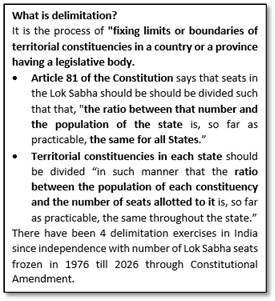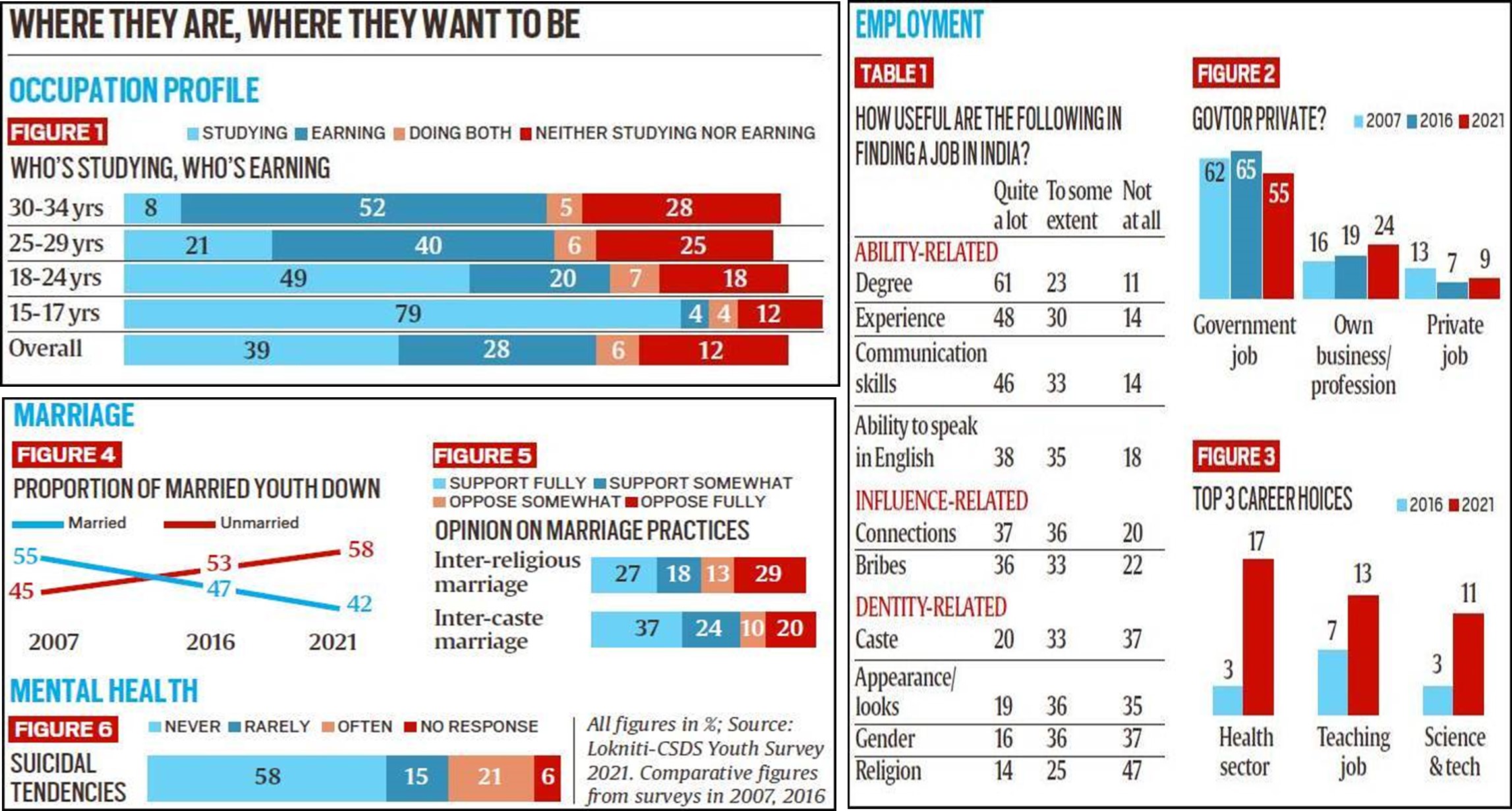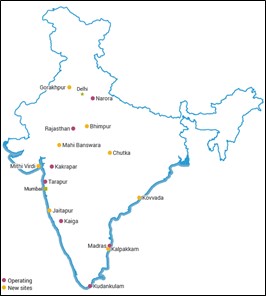Tuesday, 28th December 2021
Health Index 2019-20
In News
NITI Aayog has recently released the Health Index for the period of 2019-20
About the Report
- The objective of the Annual Health Index, prepared in collaboration with the Ministry of Health and Family Welfare (MoHFW) with technical assistance from the World Bank, is to track progress on health outcomes and health systems performance, develop healthy competition and encourage cross learning among states and UTs.
- It ranks states and Union Territories on their year-on-year incremental performance in health outcomes as well as their overall status and is a weighted composite index based on 24 indicators grouped under the domains of: Health Outcomes; Governance and Information; Key Inputs/Processes.
- To ensure comparison among similar entities, the ranking is categorized as ‘Larger States’, ‘Smaller States’ and ‘Union Territories’.
- The report for the year 2019-20 has been titled “Healthy States, Progressive India”.
- The report, however, does not incorporate the impact of Covid-19 on health outcomes or any of the other indicators as the index performance relates to base year (2018-19) and reference year (2019-20), largely the pre-Covid period.
Key Results
- Kerala has yet again emerged as the best state in terms of overall health performance among larger states the fourth round of the Health Index.
- Among the Larger States, Kerala, Tamil Nadu and Telangana emerged among the best three performers in terms of Overall Performance while Uttar Pradesh ranked at the bottom.
- However, UP ranked at the top in terms of Incremental Performance by registering the highest incremental change from the Base Year (2018-19) to Reference Year (2019-20).
- A review of the incremental performance across indicators/sub-indicators revealed that a vast majority of the larger states registered improvement in performance across the key health outcome indicators — ‘neonatal mortality rate’, ‘under-five mortality rate, ‘sex ratio at birth’ and ‘maternal mortality rate’, but there is large inter-state variation.
- Among the larger states, the highest percentage of institutional deliveries was recorded by Kerala in 2014-15 (96 per cent) and Telangana in 2019-20 (96.3 per cent) while UP had the lowest.
- In an institutional delivery, life-saving equipment and hygienic conditions reduce the risk of death and complications among mothers and infants.
- All the larger states had a shortage of required specialists in district hospitals, according to the report. This varied from 2 per cent in Rajasthan to 58 per cent in Madhya Pradesh.
- Although there is a general negative correlation between the Health Index Scores and the poverty levels of states and UTs as measured by the Multidimensional Poverty Index (recently released by NITI Aayog), many states with similar poverty index ranking fared better in health ranking. This suggests that with improved management and governance, the state/UT performance can improve irrespective of the economic or poverty level of the state/UT.
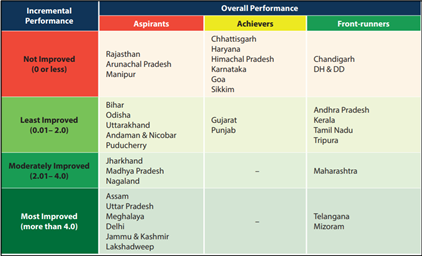
Sources:
Upskill project for Indian Gulf labours
In News
Ministry of Skill Development and Entrepreneurship to launch upskill project called ‘Tejas’ for overseas workers
About the News
- In an effort to keep Indian workers connected to the labour market of the Gulf countries, the government is launching a program ‘Tejas’
- It aims to increase skills and retrain overseas workers to cope with the requirements of the post -pandemic scene.
- Union ministry to work in cooperation with state governments, especially those sending a large number of workers to Gulf nations.
What are the major highlights of the project?
- Training: Under Tejas, or Training in Emirate Jobs & Skills, the government will train, certify and place 10,000 Indian workers in a year and 100,000 across the GCC region over the next five years.
- Bridge Courses: Creation of a bridge courses in close collaboration with Sector Skill Councils in India and employers in GCC countries.
- New Skills: Programme to be extended for those who have returned to India during the pandemic giving them an opportunity to return to their employers with new skills. It will be converged with existing skill development programmes of the Centre and state governments.
- It will leverage the training infrastructures of the National Skill Development Corporation, ITIs, Indian Institutes of Science, and private and public skill training institutions.
- Who would be Eligible?: The Tejas project extends across blue-collar jobs, including electricians, plumbers, multi-skilled technicians etc and the mid-level workforce including IT, finance and healthcare professionals.
Significance of the Project
- Expatriate Indians contribute significantly to Indian economy and are critical for strong relationship with Middle East countries.
- Upskill and re-skill will help in seeking careers especially those disrupted by the pandemic.
- Project will help to import digital skills and digitally enable youths for employment in India and abroad.
- Nearly 6 million Indians can be potentially placed in GCC countries across sectors in the next five years.
What have been the major issues with the jobs in GCC?
- According to the World Bank, nearly 75 percent of the work force employed in the private sector in the GCC constitutes expatriates.
- Negative trends in the global energy market and sustained lower oil prices have diminished opportunities in Gulf.
- Problems with ‘social contract’ creating an exploitative system for expatriates, especially for the blue-collar and domestic workers.
- The social contract is a welfare model wherein the governments provide for the financial needs and wellbeing of their nationals, including employment opportunities. While the monarchies were taking incremental measures to limit the expatriate workers’ employment in some sectors earlier, COVID-19 has led to more such measures being taken.
- The COVID-19 pandemic has further exacerbated the economic situation raising doubts about possible paths of recovery.
Sources:
Foundation of Indian National Congress
On 28 December 1885, 72 social reformers, journalists and lawyers congregated for the first session of the Indian National Union at Gokuldas Tejpal Sanskrit College, Bombay; the conference was renamed as the Indian National Congress. Allan Octavian Hume (A.O.Hume), a restricted British member of Indian Civil Service who had settled at Simla, founded the Indian National Union, the forerunner of Indian Nation Congress in 1884. The Indian National Congress dominated the Indian movement for independence from the British. In its early year the congress had no permanent organization. There were no paying member, no officials other than General Secretary, no central office and no funds. Every year the session was held in a different city with a different president and it was managed by a Local Reception Committee with locally collected funds. Yet the congress went from strength to strength because it made itself the mouth piece of national aspiration and attracted the thousands who did not attend its session.

Source:
Realizing India’s Strategic Interests in Central Asia
In News
The 3rd meeting of the India-Central Asia Dialogue was held in New Delhi on 19 December 2021.
Relevant details of the Dialogue
- The Central Asia includes 5 countries - Kazakhstan, Kyrgyzstan, Tajikistan, Turkmenistan and Uzbekistan. These are collectively called as Central Asian Republics (CARs).
- The 29-point joint statement released at the end of the dialogue mentioned Afghanistan and regional security issues as well as ways to increase trade, tourism and economic co-operation.
- India’s External Affairs Minister presented the “4Cs” concept — commerce, capacity enhancement, connectivity, and contact as the four pillars of a new geoeconomic partnership.
- India also invited the leaders of these five countries as chief guests at the 2022 Republic Day celebration.
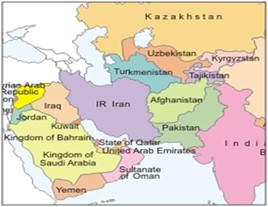
Significance of the Dialogue
- These outcomes are important as CARs are assuming major significance since the Taliban takeover of Afghanistan as the mineral rich region is becoming the centre of a new great power rivalry.
- Russia is an important player aiming to become energy superpower by harnessing Central Asian energy resources, and the US - now out of Afghanistan is also jostling for space.
- This is happening when Eurasia is at an inflection point with confrontation brewing between Russia and NATO. Washington hopes to create in Central Asia a vector of its Indo-Pacific strategy to contain China and Russia.
- Beijing has recently built deep economic ties, including trade, which is valued at $100 bn, apart from big investments in the region. The CAR are enthusiastic supporters of China’s Belt and Road Initiative.
- Pakistan is active here, while India regards the five central Asian nations as its extended neighbourhood and is now hoping to extend its influence in the region.
- The Delhi joint statement sought to emphasise the difference between India and China by committing to connectivity initiatives on the basis of “principles of transparency, broad participation, local priorities, financial sustainability and respect for sovereignty and territorial integrity”.
- Russia is an important player aiming to become energy superpower by harnessing Central Asian energy resources, and the US - now out of Afghanistan is also jostling for space.
Broad overview of India’s Central Asia Policy
- Following India’s independence, the country’s foreign policy largely focused on its immediate neighbourhood, the major powers in the international system and solidarity with other Afro-Asian colonies. It, however, did not extend to Soviet Central Asia, perhaps due to India’s robust diplomatic, defence and economic partnership with the Soviet Union.
- After the fall of the Soviet Union in 1991, India established official ties with the five CARs.
- Moreover, as India adjusted to the post-Cold War order, India has refashioned and reoriented its foreign policy in the manifestation of policy frameworks such as North Look Policy, Extended Neighbourhood Policy and Connect Central Asia Policy.
- India had several advantages in the region. These include - being the only non-communist country with a diplomatic presence in the region and being among the first to accord diplomatic recognition to the newly independent countries.
Major Cooperation – Recent Steps taken
- After signing strategic partnerships with Kazakhstan, Uzbekistan, and Tajikistan, India announced its own twelve point ‘Connect Central Asia’ policy in 2012.
- The key elements of this policy cover many important issue areas, including political cooperation, economic cooperation, strategic cooperation, regional connectivity, information technology (IT), cooperation in education, people-to-people contact, medical cooperation, and cooperation in regional groupings.
- Indian PM’s visit to the five Central Asian countries in 2015 and India’s permanent membership to the Shanghai Cooperation Organization (SCO) in 2017 have paved the way for elevated strategic cooperation between India and CARs.
- In 2019, New Delhi initiated the ‘India-Central Asia Dialogue’ at the Foreign Ministers level including Afghanistan. During the same year, bilateral relations with Kyrgyzstan were also elevated to a ‘strategic partnership’.
- The India and Central Asia strategic cooperation has benefited from this dialogue framework. Many of the initiatives presented at the First Summit (2019) have come to fruition, including forming an India-Central Asia Business Council (ICABC). Many additional development projects are in progress.
- In 2020, The Second Dialogue was convened virtually due to the COVID-19 pandemic. India has extended a $1 billion Line of Credit (LOC) for priority development projects in energy, healthcare, connectivity, IT, agriculture, education, etc.
- In this line, the third dialogue has set the stage for intensifying bilateral relations. In this Dialogue, an emphasis on expediting commerce, connectivity, capacity building, and contact was laid by India.
Potential challenges in executing India’s Central Asia Policy
- Geo-economic engagements despite many policy frameworks have not been showing any sign of improvement in terms of trade and investments. India’s current trade with Central Asia, relatively at $2 billion is far less than Central Asia’s trade with Russia, China and the US which stood at the value of US$ 20.46 billion, US$ 32.60 billion and US$ 26.13 billion respectively in 2015.
- Energy cooperation is the main foundation of the regional cooperation. But TAPI gas pipeline, started in 1995 originating from Galkynysh gas field (Turkmenistan) to reach Fazilka (India) has not been realized till date.
- The Main reason for low economic and strategic cooperation is connectivity issue. For India to reach Central Asia, the shortest route goes via Pakistan and Afghanistan. Since Pakistan’s hostility with India and its cooperation with China against India are evident, overland connectivity with Central Asia remains problematic. The various connectivity projects like Chabahar Port, Ashgabat Agreement, and INSTC are yet to be realized of their full potential and still under development.
- The other problem is that both Pakistan and Afghanistan are not secure and stable countries, so even if India shared good relations with Pakistan, this route to Central Asia from India is not a safe and reliable path for trade and commerce.
- The differences between the CARs on how to proceed on Afghanistan: Russia has been balancing its relations with the Taliban through these republics. Tajikistan, which has strong ties with Russia, for instance, has a different, more confrontational approach to the Taliban than Uzbekistan’s conciliatory attitude, because of cross-border links with the mostly-Tajik Northern Alliance.
Way Forward
- India should utilise the SCO to enhance the cooperation with CARs while keeping an eye at Pakistan and China.
- Iran is crucial partner in connecting India to Central Asia. This is virtually the shortest route to CARs given situations in Afghanistan and relations with Pakistan. India should exercise its strategic autonomy to deal with Iran amid US sanctions on Iran while balancing its ties with the US.
- It is in India’s interest to expeditiously finalise the much-awaited Free Trade Agreement (FTA) between India and the Eurasian Economic Union (EAEU). If finalised without delay, the FTA with EAEU will give India direct access to the region’s huge hydrocarbon resources as well as open doors to the Eurasian markets.
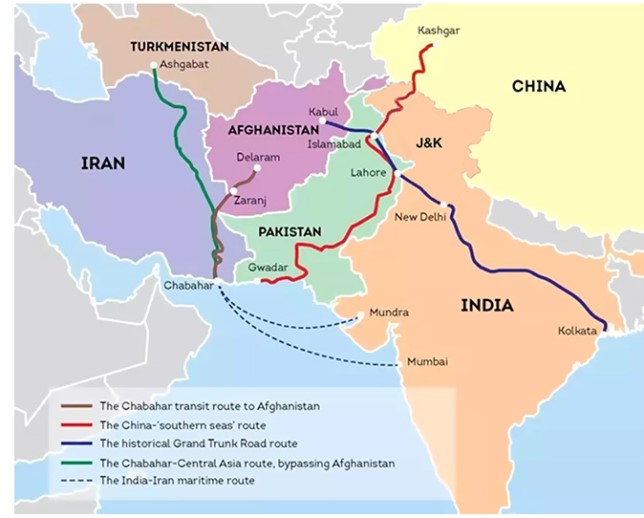
Conclusion
The CARs started looking for new partners like India to balance China’s hegemonic pursuits. India, for its part, reinvigorated its strategy towards the region by the ‘Connect Central Asia’ policy. How far India and Central Asian countries will take this renewed, centuries-old relations remains to be seen. India must take into consideration its future energy needs and the market potential of the greater Eurasian region, and seize the opportunity to stretch its economic borders while maintaining its constructive approach.
Question: As India looks beyond its borders, Central Asia provides India with the right platform to leverage its political, economic, and cultural connections to play a leading role in Eurasia. Discuss.
Sources:
- Joint Statement of the 3rd meeting of the India-Central Asia Dialogue
- India’s Central Asian outreach
- Realizing India’s Strategic Interests in Central Asia
- India and Central Asia: The Strategic Dimension
- What is India's diaspora policy in Central Asian countries?
- India strategic ally of all central Asian countries: Kyrgyzstan minister
- India’s Connect Central Asia Policy
- India's Interests in Central Asia
- Ready to take ties to next level: India to 5 Central Asian countries
- Third India-Central Asia dialogue: Shifting gears of India’s Central Asia policy
- China is rising in Central Asia, a friend is worried, and we need access
- Why India must re-work its Central Asia strategy
- India-Central Asia Relations
- India’s Strategic Interests in Central Asia in the Post-Soviet Years: Expanding Vistas of Partnership
- India-Central Asia relations: Expanding vistas of partnership
- How 3rd India-Central Asia Dialogue helps make great strides towards a stronger partnership
- A strategic bulwark: On third India-Central Asia Dialogue
- China, Russia jittery as India intensifies Central Asia outreach
- India is keeping an eye on Central Asia
- India on the right track to bolster relations with Central Asia
- India’s Aims in Central Asia and India-Afghanistan-Iran Triangular Relationship
- India-Central Asia Relations
- What is the importance of each of the five Central Asian countries for India?
- The Strategic Significance of Central Asia
- Withering Away of India’s Central Asia Policy
- INDIA’S GAMBIT IN THE CENTRAL ASIAN ABYSS
- India-Central Asia Dialogue: India Goes All Out To Woo Afghanistan’s Central Asian Neighbours
- Meeting between India and Central Asian Republics underscores shared concerns on Afghanistan
World’s Largest Fish
This is image of a whale shark, the world's largest fish. Some local fishermen rescued a shark entangled in the shore fishing net on Tantadi beach in Andhra Pradesh's Visakhapatnam. The shark was later guided back to the sea by the forest department officials. A Whale shark has been categorized as Endangered in the IUCN Red List. Numbers of whale sharks (Rhincodon typus), the world’s largest living fish, have more than halved over the last 75 years as these slow-moving sharks continue to be fished and killed by ship propellers. Although conservation action in India, the Philippines and Taiwan has ended large-scale fishing of whale sharks in these countries, they continue to be fished in other locations, including southern China and Oman. As whale sharks and tuna are often present together, they are frequently caught by fishers targeting tuna.
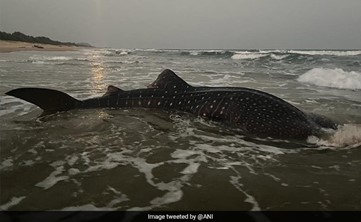
Sources:
5G services to roll out in 2022
In News
The Fifth Generation or 5G telecom services are set to be rolled out in selected cities in India in 2022.
About the News
- The cities which are set to get the 5G telecom services in 2022 include Gurugram, Bangalore, Kolkata, Mumbai, Chandigarh, Delhi, Jamnagar, Ahmadabad, Chennai, Hyderabad, Lucknow, Pune, and Gandhinagar.
- Leading telecom service providers Bharti Airtel, Reliance Jio and Vodafone Idea, have established 5G trials sites in these cities.
Implementation Plan
- What is 5G? The fifth-generation is the latest upgrade in the long-term evolution (LTE) mobile broadband networks.
- Stakeholders in rolling out 5G: Agencies including IITs of Bombay, Delhi, Hyderabad, Madras, Kanpur, IISC Bangalore etc are involved in the research project called 'Indigenous 5G Test bed project'.
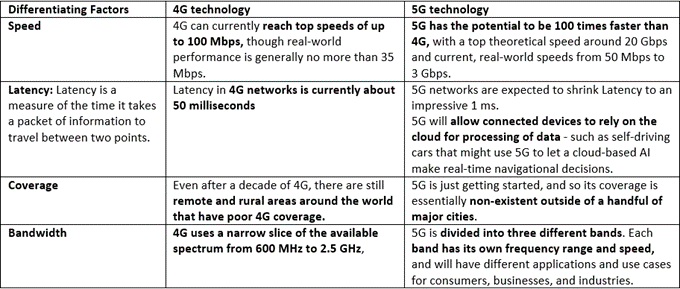
The Indigenous 5G Test bed project
- Test bed refers to creating a specific environment for testing the products or services. It includes hardware, software, operating system, and network configuration.
- Inception: The project started in 2018 and is set to be completed by December 31, 2021. It has been funded by the Department of Telecom.
- Objective: It is a technology development project in telecom space for development, testing and proliferation of 5G technology system components, cross-sectoral use cases, besides setting up the foundation for the development of "6G Technology landscape" in the country.
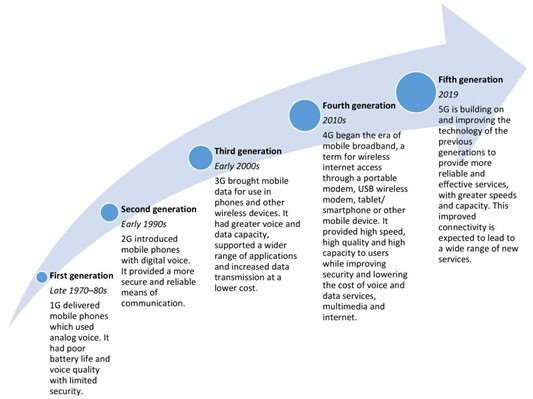
Source:
- 5G services to roll out in four metros, selected cities in 2022
- 5G services to roll out in India's four metros, selected cities in 2022
Image Source:
Magnetar
- Context: An international group of researchers has succeeded in measuring for the first time the characteristics of a flare on a distant magnetar.
- Eruptions in magnetars are believed to be due to instabilities in their magnetosphere, or “starquakes” produced in their crust - a rigid, elastic layer about one kilometre thick. This causes waves in the magnetosphere, and interaction between these waves causes dissipation of energy.
- This magnetar is about 13 million light years away, in the direction of the NGC 253, a prominent galaxy in the Sculptor group of galaxies.
- A magnetar is a rare compact type of neutron star teeming with energy and magnetism.
- Magnetars are relatively rare objects, with only about thirty having been spotted within the Milky Way so far. The present magnetar is only the second one to be studied which is located outside the galaxy and is also the furthest, at 13 million light years distance.
- Magnetars have high magnetic fields in the range of 1015 gauss and they emit energy in the range given by luminosities of 1037 – 1040 joules per second. Compare this to the luminosity of the sun which is in the order of 1026 joules per second – a factor of at least 1011 lower.
- Magnetars are very difficult to observe when they are silent. It is only during a flare that they can be observed, and these flares are so short-lived that it presents a formidable problem.
Source:
Special package to A.P.
- Context: Recently, the Union Minister of State for Finance has asserted that the Central government has extended a special package in lieu of the Special Category Status (SCS) to Andhra Pradesh.
- Keeping in mind the obligation emanating from the Andhra Pradesh Reorganisation Act, 2014; the recommendations of the Finance Commissions; the report dated December 1, 2015 of Vice Chairman, NITI Aayog, and the request of the successor State of Andhra Pradesh, the Special Assistance Measure to the successor State of Andhra Pradesh was extended.
- The SCS for plan assistance was granted, in the past, by the National Development Council (NDC) to States that were characterised by a number of features necessitating special consideration.
- The features included hilly and difficult terrain, low population density and/or sizeable share of tribal population and strategic location along borders with neighbouring countries. Also, economic and infrastructural backwardness and non-viable nature of State finances were other criteria.
- The decision for Andhra Pradesh was based on an integrated consideration of all the factors listed above and the peculiar situation of the State.
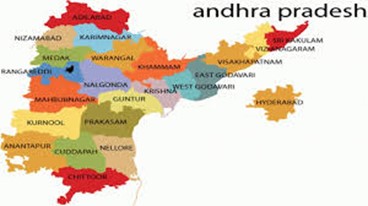
Source:
Anti-apartheid icon: Desmond Tutu
- Context: South African Archbishop Desmond Tutu has recently passed away.
- Desmond Tutu was an anti-apartheid icon who opposed racial discrimination in South Africa.
- He used his international profile to lobby for sanctions against the White-minority government.
- From 1996 to 1998, he led the Truth and Reconciliation Commission that aimed at exposing the injustices of the past.
- He was a patriot without equal; a leader of principle and pragmatism who gave meaning to the biblical insight that faith without works is dead.
- With many of South Africa’s Black leaders in jail, including Nelson Mandela, and others in exile, Tutu emerged as a leading voice of Black defiance against apartheid.
- He was awarded the Nobel Peace Prize in 1984 for his role as a unifying leader figure in the campaign to resolve the problem of apartheid in South Africa.
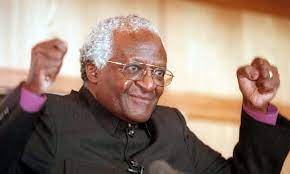
Source:
ASIGMA App
- Context: The Indian Army has recently launched a contemporary messaging application named ASIGMA.
- ASIGMA stands for Army Secure IndiGeneous Messaging Application.
- It is a new generation, state-of-the-art, web-based application developed entirely in-house by a team of officers of the Corps of Signals of the Army.
- It is deployed as a replacement of Army Wide Area Network (AWAN) messaging application which has been in service for past 15 years.
- The app will meet all futuristic user requirements and has an enhanced user experience.
- It has a variety of contemporary features including multi-level security, message prioritisation and tracking, dynamic global address book and various options to meet the Army’s requirements alongside real time data transfer and messaging especially in the backdrop of current geo-political security environment.
- It is in line with the government’s ‘Make in India’

Source:
- Indian Army launches in-house messaging app ASIGMA
- Indian Army Launches New In-House App 'ASIGMA' For Secure Messaging
Image Source:
Growing divergence in central and state-level fiscal trends: IE
Essence: The article draws the attention on the growing divergence between the fiscal trends of Government of India and State governments. Some relief can be observed in the reduction of the fiscal deficit of the center due to incremental revenues on account of robust performance of direct taxes and surplus from RBI. But at the same time expansion could be seen in the state governments’ fiscal deficit due to reasons like slow growth in tax and non-tax revenues along with fall in transfers from state to the center.
Despite the expansion seen in Centre’s tax revenue, there is fall in the devolution to the states. There are two ways of seeing this, one is the sustained deterioration in the cash flows and the other is chance to state to change their strategy to avail cheaper source of funds. The pending GST compensation to states would help them sustaining the cash crunch likely to be created after the compensation period ends.
Why you should read this article?
- To understand the reason of increase in the revenues of the central government.
- To understand the reason for growing divergence between the central and states fiscal trends.
- To understand the reason for decrease in the cash flows for the state government.
Source:
An agenda to foster digital inclusion in India: HT
Essence: Having smartphones today is an important step towards digital revolution, automatic self-development of people and it ensures full digital inclusion. Though India has impressive numbers of smartphone users, there are still around 600 million users who do not have it. A drive like that of Aadhar is needed to get the most disadvantaged Indians into mainstream with a smartphone in their hands.
In order to achieve this goal steps have been suggested in the article like access, connectivity in the remotest areas, training to learn functionality of phones, use of regional languages etc. Government and Civil society can join hands and enhance digital inclusion in areas like Education, Health, Skill development, E-Commerce, Disaster Management etc. It will help us to meet the United Nations Millennium Development Goals, improve economic productivity, and attack pervasive inequality in India.
Why to read this article?
- To understand how Smartphones can act as a tool for digital inclusion in India.
- To know those areas where digital inclusion can enhance by an active role of Government and Civil Society.
- In the era of pandemic, digital literacy and digital inclusion is a compulsory norm. this is an article written in a lucid language covering one of the aspects of digital revolution (GS II, GS III and Essay).
Source:
Space: The Militarized Global Common: ORF
Essence: In the light of ASAT test capability by USA, China, India and Russia, the article revolves around the issue of militarization of space, the loopholes associated with the present Outer Space Treaty (OST) and how they could be tackled. Though mentioned as a global common in international treaty, space is still treated as an entity for the national usage by USA, as reflected in USA’s policies and head of state speeches. Development of Space Force by USA is one such example.
Peaceful usage of space has been interpreted to the advantage of capable nations. Russia considers non-military as the meaning of peaceful and USA considers non-aggressive theory for considering what constitutes peaceful usage. There is vagueness around what kind of weapons constitute mass destruction/nuclear capable as it leaves scope for conventional weapons and the civilian missions to conduct harmful activities in space.
What is needed is an effective regulatory mechanism for space- the global common, at an international level as each nation’s conduct in space affect all countries on the planet.
Why you should read this article?
- To understand how the present Outer Space Treaty is being exploited by few nations to their advantage.
- To understand the need of the hour, establishment of an international treaty with legal powers to demilitarize space.
Source:
Karnataka’s e-governance initiatives
Background
- A 2018 Lok-Niti team survey at the Centre for the Study of Developing Societies found that less than 25 percent of Indians trust the policy and governance due to the factors such as: interactions with the govt officials can be frustrating, time-consuming and costly.
- In order to reach people and with a view to making them partners of the systems and processes of governance, Karnataka ensured greater emphasis on e-government.
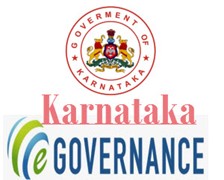
How does Karnataka government’s initiative?
The smart initiative of Karnataka aimed to provide direct citizen interface, improve human resources and connectivity to improve the efficiency of government officials. Some of the following areas are:
- Secretariat Local Area Network (LAN): It enables citizens to know the status of their file and the number of days they took to be cleared at various stages.
- Mukhya Vahini: It summarizes data on major projects in health, housing, and other social sector schemes. This enhances transparency and improves quality.
- Khajane: The system keeps accounts for all payments of the state, ensuring transparency and
- com: This programme envisages 225 training centers all over the state run by prestigious firms. The programme aims to train over 1,00,000 rural youths in a year.
- Bhoomi and Nondani: Bhoomi is the state's computerized land records project.
- Tax Department: The Commercial Tax Department tracks goods using check post entries. Data about movement of goods is automatically put in the dealers assessment file.
- These initiatives reflect that Governance needs to be oriented towards building and strengthening human capacities and creating an environment that fosters individual dignity, equality and sustainable human development.
Quote: “Strong government doesn't mean simply military power or an efficient intelligence apparatus. Instead, it should mean effective, fair administration - in other words: good governance.”
- Raghuram Rajan
Source:
Share the article
Get Latest Updates on Offers, Event dates, and free Mentorship sessions.

Get in touch with our Expert Academic Counsellors 👋
FAQs
UPSC Daily Current Affairs focuses on learning current events on a daily basis. An aspirant needs to study regular and updated information about current events, news, and relevant topics that are important for UPSC aspirants. It covers national and international affairs, government policies, socio-economic issues, science and technology advancements, and more.
UPSC Daily Current Affairs provides aspirants with a concise and comprehensive overview of the latest happenings and developments across various fields. It helps aspirants stay updated with current affairs and provides them with valuable insights and analysis, which are essential for answering questions in the UPSC examinations. It enhances their knowledge, analytical skills, and ability to connect current affairs with the UPSC syllabus.
UPSC Daily Current Affairs covers a wide range of topics, including politics, economics, science and technology, environment, social issues, governance, international relations, and more. It offers news summaries, in-depth analyses, editorials, opinion pieces, and relevant study materials. It also provides practice questions and quizzes to help aspirants test their understanding of current affairs.
Edukemy's UPSC Daily Current Affairs can be accessed through:
- UPSC Daily Current Affairs can be accessed through Current Affairs tab at the top of the Main Page of Edukemy.
- Edukemy Mobile app: The Daily Current Affairs can also be access through Edukemy Mobile App.
- Social media: Follow Edukemy’s official social media accounts or pages that provide UPSC Daily Current Affairs updates, including Facebook, Twitter, or Telegram channels.

